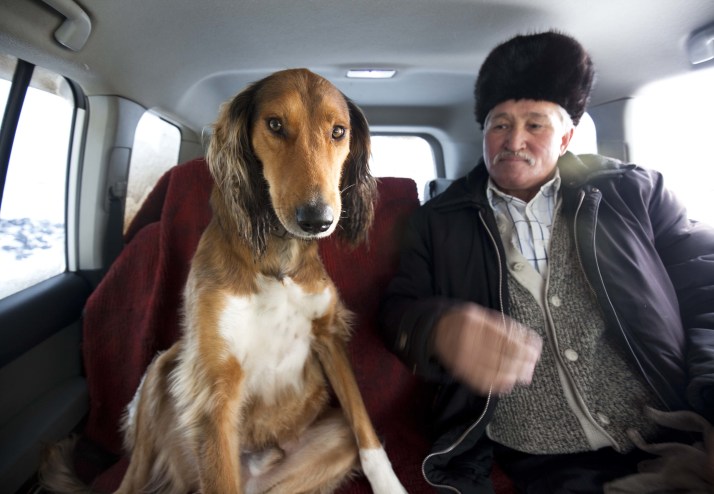
A Tazy named Akbakai, meaning White Paw, lopes across the steppes. Tazies can run at speeds upwards of 30 m.p.h. PHOTOGRAPH BY RYAN BELL
“Faster!” Zhylkybai Aga said.
The driver increased the truck's speed to 25 m.p.h. Zhylkybai leaned out the window and whooped at his dog, named Akbakai, who loped alongside the vehicle. The lanky dog was hardly exerting himself.
My first impression of Tazy, a Kazakh dog breed, was that it looked like a bag of bones. But now, in motion, it had transformed into a thing of beauty. Through the snaredrum-tight skin, I could see the legs and hips working. They bounded him across the steppes, making Akbakai's feathery ears flap like wings.

Zhilkybai Aga raises Tazies to keep up the tradition of his father, a renowned hunter who reportedly killed 1,000 wolves. PHOTOGRAPH BY RYAN BELL
The Tazy’s ancestry is unclear. It shares DNA with a cluster of similar-looking breeds from central Asia, the Middle East, and north Africa. In Kazakhstan, lanky dogs appear in 3,000-year old petroglyphs. And not far from where Akbakai now ran, dog bones were found in a Botai burial grave, a Copper Age civilization that kept domesticated dogs and horses.
During nomadic times, Tazies were prized for their ability to run down and kill wolves. The skill earned them special status in Kazakh culture, where it's still considered taboo to merely refer to Tazies as "dogs." They were treated like family members and allowed inside the yurt. And in ancient times, it’s been said that a Kazakh would trade 47 horses for one good Tazy.
In Kazakhstan, Tazies once numbered in the tens of thousands. Now only a few hundred of the breed are left. PHOTOGRAPH BY RYAN BELL
Today, the Tazy breed is endangered. In 2014, Kansonar, a national hunting group, organized a dog show in the capital city of Astana. Breeders from around the country showed 157 Tazies. Krasnosar collected measurements of every dog in the hope of creating a Tazy breed registry. That, they hope, will raise the breed’s profile and encourage more buyers in order to grow the population.
But the question remains: how many horses will each dog cost?
*****
Ryan Bellis a Fulbright-National Geographic Fellow, travelling through Russia and Kazakhstan for his project #ComradeCowboys. Follow his adventure onTwitter, Instagram, and Facebook. Get updates about his work at Storify.